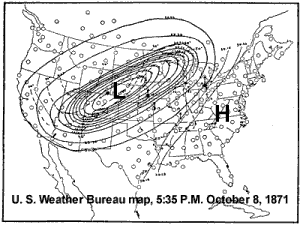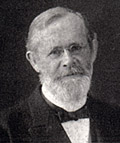 |
 |
| Home | Welcome | What's New | Site Map | Glossary | Weather Doctor Amazon Store | Book Store | Accolades | Email Us |
 | ||||||||||||
Cleveland Abbe:
|
||||||||||||
|
In January, 1871, the Chief Signal Officer General Albert J. Myer appointed Cleveland Abbe
professor of meteorology, a civilian assistant in the office of the Chief Signal Officer, making
Abbe one of the nation's highest paid scientists at the time. His initial salary of $3,000 increased
to $4500 the following year.
Colleague T.C. Mendenhall would later write in memorial:
"At that time he [Abbe] was the only man in the country having experience in or knowledge of weather forecasting for the use of the public based upon the principles of scientific meteorology, and for some time the duty of tri-daily interpreting the meteorological observations made in all parts of the country devolved upon him alone."
Within the Signal Corps, Abbe organized the forecast division and soon began preparing those three-a-day synopses and "probabilities" of the weather, as weather forecasts were then. Abbe later recalled:
"After a month's practise it was decided that my forecast would evidently more than fill the popular expectations, and tri-daily publications began at once. The term 'probabilities' then became official, as it had begun in October, 1869, and in those days it was appropriate; but we have long since substituted the word 'forecast.'"
On February 19, 1871, Abbe issued the first public Weather Synopsis and Probabilities based on
observations taken at 7:35 a.m. An early example reports:
"Synopsis for past twenty-four hours; the barometric pressure had diminished in the southern and Gulf states this morning; it has remained nearly stationary on the Lakes. A decided diminution has appeared unannounced in Missouri accompanied with a rapid rise in the thermometer which is felt as far east as Cincinnati; the barometer in Missouri is about four-tenths of an inch lower than on Erie and on the Gulf. Fresh north and west winds are prevailing in the north; southerly winds in the south. Probabilities; it is probable that the low pressure in Missouri will make itself felt decidedly tomorrow with northerly winds and clouds on the Lakes, and brisk southerly winds on the Gulf."

The demands of the new agency required a trained corps familiar with observational, theoretical,
and operational meteorology. To educate its officers, Abbe, established meteorological training
classes at local weather offices supplemented with educational notes provided by experts from
around the country. In 1885-86 at Fort Myer in Arlington, Virginia, a class of select officers
attended an extensive course of lectures and instruction: the theory of instruments, chartography,
general meteorology, thermodynamics of the atmosphere, taught by Abbe; theoretical
meteorology without mathematics taught by William Ferrel; practical meteorology and weather
predictions, topographic surveying and drawing taught by H.H. Dunwoody; and electricity and
laboratory manipulation taught by T.C. Mendenhall.
In 1873, Abbe inaugurated the Monthly Weather Review, then only a brief bulletin of current
weather statistics but which twenty years as an enlarged publication soon became one of the
leading meteorological journals of the world under his editorship. He was a voluminous
contributor to scientific journals and reference books as well as to official Weather Bureau
publications until his death, mostly synthesizing or translating the meteorological research of
others.
|
Needing the weather observations collected uniformly in time across the nation, Abbe divided
the United States into four standard time zones, eventually convincing the railroads in 1883 to
adopt the four time-zone system used today.
While a brilliant organizer of data collection and dissemination with wide vision, Abbe
nevertheless saw the importance of meteorological research and organized a branch of the
Central Weather Office -- known at first informally, and later officially, as the "study room" -- in
which many successful scientific investigations were carried out. He would later expound on the
need for continuing research:
"True science is never speculative; it employs hypotheses as suggesting points for inquiry, but it never adopts the hypotheses as though they were demonstrated propositions. There should be no mystery in our use of the word science; it means knowledge, not theory nor speculation; nor hypothesis, but hard facts, and the framework of laws to which they belong; the observed phenomena of meteorology and the well-established laws of physics are the two extremes of the science of meteorology between which we trace the connection of cause and effect; insofar as we can do this successfully, meteorology becomes an exact deductive science."
As early as 1876, Abbe tried to establish meteorology's place in academia, petitioning
universities with proposals for a curriculum that would provide baccalaureate and advanced
degrees in the subject; however, the first college departments of meteorology would not be
established until the 1930s. Abbe held an adjunct professorship of meteorology beginning in
1884 at Columbian (now George Washington) University where he supervised the training of
Weather Service personnel, and he was a frequent lecturer at Johns Hopkins University. In fact,
Abbe offered his extensive library of meteorological literature in exchange for a commitment by
Johns Hopkins University for a course of instruction and research in meteorology. Although the
library found its home there, Abbe was never satisfied with the level of commitment to
meteorological education.
His scientific achievements were recognized by many learned societies including the Royal
Meteorological Society who in 1912 through its Symons Memorial Gold Medal, cited Professor
Abbe "has contributed to instrumental, statistical, dynamical, and thermodynamical
meteorology, and forecasting," and "has, moreover, played throughout the part not only of an
active contributor, but also of a leader who drew others into the battle and pointed out paths
along which attacks might be successful."
Abbe became popularly known as "Old Probs" or "Old Probabilities" across America. Abbe later remembered the event, when he was in his early 30s, from which the moniker arose:
"This bulletin [the first number of the Cincinnati Weather Bulletin issued on September 1, 1869], in my own handwriting, was posted prominently in the hall of the Chamber, but unfortunately I had misspelled 'Tuesday', and I soon found below my probabilities the following humorous lines by Mr. Davis, the well-known packer: 'A bad spell of weather for 'Old Probs.' This established my future very popular name of 'Old Probs.'"
As the years passed, the name became more and more appropriate as he became the patriarch of American weather. Although he remained with the US Weather Bureau until his death in 1916, the infirmities of advancing years prevented Abbe from taking a fully active part in the work of the Bureau in his final years.
Abbe was married to Frances Martha Neal in 1870, and they had three sons. Frances died in
1908, and he married Margaret Augusta Percival in 1909. He died at his home in Chevy Chase,
Maryland in the early morning hours of October 28, 1916 at age 78.
Announcing his death, the Weather Bureau statement read:
 "Professor Abbe's life was one of unusual simplicity and devotion to science, especially to meteorology and climatology...Gentleness and kindness reached their heights with him and, aside from his world-wide recognition as a meteorologist, he will be remembered always as a man that was universally loved. " "Professor Abbe's life was one of unusual simplicity and devotion to science, especially to meteorology and climatology...Gentleness and kindness reached their heights with him and, aside from his world-wide recognition as a meteorologist, he will be remembered always as a man that was universally loved. " |
 |
To Purchase Notecard, |
Now Available! Order Today! | |
 |
 |
NEW! Now |
The BC Weather Book: |


